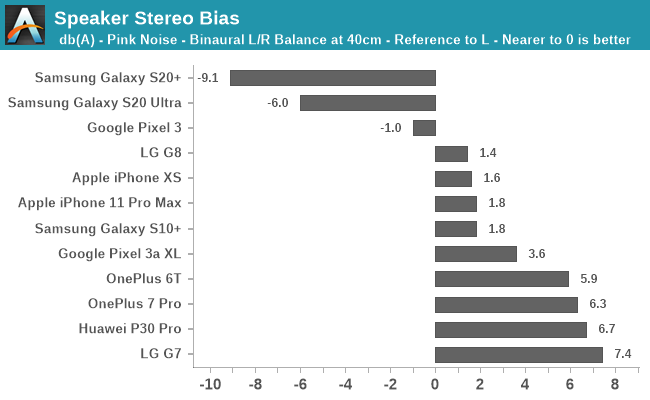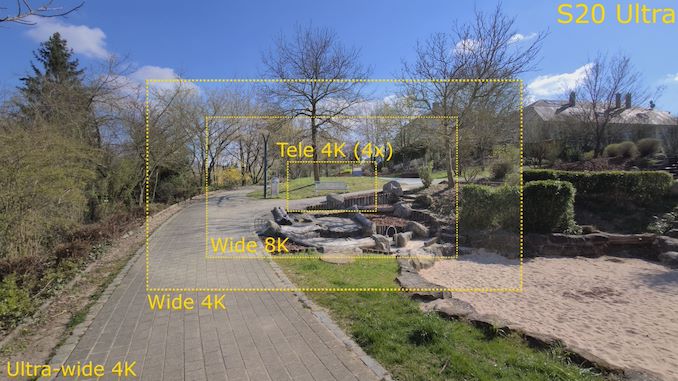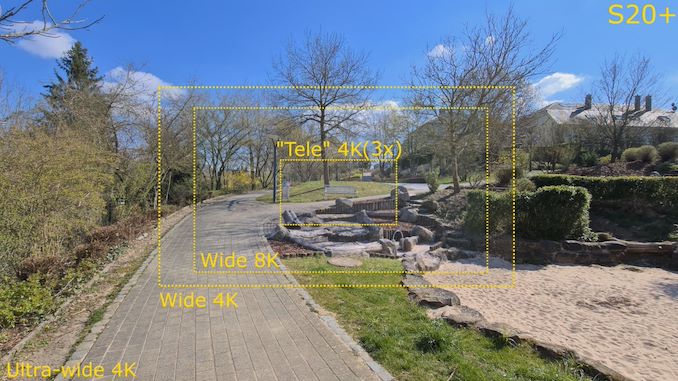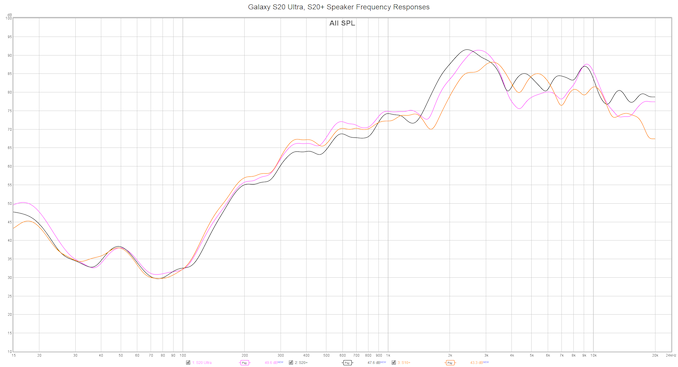The Samsung Galaxy S20+, S20 Ultra Exynos & Snapdragon Review: Megalomania Devices
by Andrei Frumusanu on April 3, 2020 9:30 AM ESTVideo Recording: Triple Cameras, 8K Recording?
Amongst the biggest hype features of the S20 series was their ability to capture 8K video. These are not only amongst the first mobile phones on the market to proclaim this capability, but they’re also amongst the first ever consumer cameras on the market, with the feature being previously just being available to professional equipment.
S20+ (E) S20 Ultra (E)
S20 Ultra (S)
Video quality on the phones on the main sensors and the usual 4K30 and 4K60 recording modes are excellent, with details and dynamic range being excellent. The above video samples this year remain in the default SDR recording profile, as Samsung HDR+ recording a “Labs” feature, and we saw it have quite the complication last year on the S10 series.
One thing I want to make note about the S20 Ultra is that a lot of people were complaining about focus issues of the camera, and I indeed also encountered that phenomenon, with some horrible results on the Snapdragon S20 Ultra (4K30 video sample). Fortunately, Samsung had already released a firmware update which fixed the issue on the Exynos model, and the sensor’s new PDAF system almost equally as fast as the dual-pixel PD of the Galaxy S20+.
A new video recording feature of the S20 series is the “Super Steady” mode. This mode is limited to FHD resolution and uses digital stabilisation to produce – well, a super steady video recording. The quality here however isn’t great, because what the phone is actually doing is cropping into a stabilised frame of the Ultra-Wide-Angle camera module, not being able to use the other camera modules at all even though the UI is a bit misleading in allowing you to switch between wide-angle and ultra-wide-angle perspectives.
Before going into the 8K samples, we have to talk a bit about how the phones actually achieve this. On the S20 Ultra, 8K recording obviously only is able to be done through the primary 108MP camera sensor as it’s the only unit with sufficient resolution to actually support it. The problem is, that the camera sensor isn’t able to super-sample the 8K video recording across the whole camera sensor, and instead uses a 1:1 crop of pixels of the sensor. Because the sensor’s native resolution is 12000 x 9000, it means it has to crop quite a bit to end up at the 8K video recording resolution of 7680 x 4320, resulting in a narrowed field-of-view, as you see in the above superimposed snapshots of the different video modes.
The S20+ on the other hand uses the secondary wide-angle module – again that’s simply because it’s the only module that is sufficiently high resolution to support the 8K resolution. Its native resolution here is only 9248 x 6936, meaning that it only has to crop a relatively smaller region of the sensor to fit in the 8K video frame. It means that the S20+ actually has a wider 8K field of view than the S20 Ultra, which I actually find to be much preferable for most use-cases.
The funny thing is that I have a hard time evaluating the video quality as currently I don’t even have any display in the house that’s able to natively display the full 8K video. If you’re lucky enough to have an 8K TV at home, I probably recommend casting the YouTube video to that device. For us mere mortals with 4K displays, all I can say is that the video looks absurdly sharp, and almost every frame of the video is almost the quality of a still camera capture.
Usually you’re used to digital cropping to be a mess, but even at up to 6x magnification within the video things still astoundingly good. I noted focusing is a bit slower on all the phones, and the S20+ really didn’t like switching over to close objects. Taking a few steps back did help the phone find its bearings.
Overall, the results are just outstanding, and I’m looking forward to what people will be able to achieve with help of professional video editing and camera work.
Speaker Evaluation
The speakers on the S20 series have undergone a rather drastic redesign, most of it due to the phone’s front camera design. Because the front camera is now at the centre of the display, Samsung was no longer able to house the earpiece speaker right next to the usual earpiece grill location. On the S20 series, the actual speaker is now located below the front camera, with an audio channel leading to a sliver thin gap between the display glass and the device’s frame. This fundamentally changes the audio characteristics of the phone, and it’s not all positive.

The biggest change is the fact that the new earpiece speaker is extremely loud, but also weirdly enough not very front directional. Holding the phone one-handed in portrait mode the phone doesn’t sound as loud as the S10+, but as soon as you hold it in landscape and use your palms as natural cups to focus the audio, the full brunt of the earpiece speaker is focused towards you. Interestingly enough, the smaller S20+ here becomes significantly louder, more-so than the S20 Ultra.

The new earpiece also largely overwhelms the bottom firing main speaker when it comes to loudness. The new speaker here is significantly bigger than that of the S10 series, and it has a fuller frequency response, particularly in the high-ends.
What this means that for generic pink noise and most other audio, you’ll have the impression that there’s a heavy bias towards the earpiece speaker, the complete opposite of what we’re used to as traditionally it’s been always biased towards the main speaker.
In terms of the actually audio quality, it’s still excellent, but it does have a different audio signature. The high-ends are a lot more pronounced on the S20 phones, which might need some getting used to.
The S20+ and the S20 Ultra also have somewhat different sound. Compared to the S10+, the S20+ definitely loses some “fullness”, and that’s due to the weaker low-mid ranges. The S20 Ultra is able to maintain more of these frequencies, and it sounds better than the S20+, more familiar to the sound of the S10+, but with the added clarity of the new more pronounced high-ends.
I do think that Samsung should tone down the earpiece speaker a bit - its high-end frequencies are maybe a bit too much and it just is a bit too loud in relation to the main speaker – particularly on the S20+. I could see some people being put off by the audio signature here as it is more tiring that that of the S10+.
And of course, I have to complain about the new phone’s lack of a 3.5mm headphone jack. With Samsung being the last major flagship vendor dropping the jack, it’s a nail to the coffin for the audio connector. Not too much to add here other than I’m disappointed in how things have devolved – all in the name of selling more accessories.













137 Comments
View All Comments
iphonebestgamephone - Sunday, April 5, 2020 - link
Oh and what does a pro like you use?sanjeev.k - Saturday, April 4, 2020 - link
Hi Andrei,Thanks for your detailed review. Any change Anandtech will be reviewing the note 20 later in the year (as Anandtech have not reviewed the note xx series past few years) ?
Reliable leaker @IceUniverse hints that Note series will implement an optimised solution for 120 Hz refresh rate - so I am assuming that to mean that power inefficiency issues at 120 hz refresh rate will be fixed in the note series.
If you are going to review the Note series, at least we will know whats the improvement like as compared to Galaxy S series. Then I can decide if I want to import the Snapdragon 865 Note series or import S20 865 series and bear with the 120 Hz power consumption issue
abufrejoval - Saturday, April 4, 2020 - link
I bought the first Galaxy Note for its size: My hands are much more capable than my eyes up close. I stuck around for the Note 3 and then abandoned the brand as they went off into Absurdistan with too much glass and metal replacing replaceable batteries (both Notes still work today with 2nd and 3rd sets of batteries).But I’ve always longed to see another feature become mainstream usable, that these Notes started, albeit with serious functional limitations: Desktop or docking mode.
The Note 2 dock also worked with the Note 3 and it was the first that I tried to use for extra light business travel with a foldable BT keyboard even a BT mouse on an HDMI connected big screen. Mixed DPI support wasn’t quite up to snuff, even with custom ROMs that added Ethernet connectivity (security constraints mandated that in some cases).
In terms of computing power everything since the 820 has been enough for me in mobile use: If I really want to crunch numbers, I use HPC servers which I access via SSH, RDP or VNC and gaming is much more fun with an RTX 2080ti.
Phones as a VR headset replacement died far too quickly for my taste, my Le Max2 with its Le VR “luxury cardboard” companion still works pretty well, certainly for 3D movies.
So, the only reason I would even remotely consider buying one of these overpowered smartphones is if they could do double-duty as mid-line laptop replacements. Unless Corona’ed I switch countries every week and taking a €1200 smartphone instead of a €1200 laptop along for the ride, while enjoying a 43”@4k desktop in both offices has a great appeal, especially since RAM (16GB), storage (500GB) and compute power are similar enough to satisfy me.
I need both to handle the typical office/productivity stuff, surfing and the ability to access the big systems, be they compute farms or GeForce Now if I am in need for a monster kill. Yes, I love to be able to even run a Docker container in case I want to code something on the quick and up to chroot() that works pretty well with Android’s Linux kernel, even if it’s not quite as podman ready as the laptop.
Last Samsung I got was a Tab S5e a month ago and its DEX qualities are really much improved. It has perhaps 25% of the power and capacity of these phones (at 50% price) but shows what could obviously be done here. Yet I see no mention of DEX on the S20 and I fear that Samsung’s product management is…
The mere existence and perseverance of Exynos SoCs and rounded display edges prove that these people must be insane: Very sad, when you consider what the hardware could actually do!
In the mean-time I am holding on to a very nice OnePlus 5 as daily driver, lovingly protected with a silicon sleeve that sports an elevated ridge around a flat display thus kept from drop’s harm with grip and buffer space. When I take it out for a bit of soap and water treatment, it looks like new.
Chassis materials, colors, design, finger tip smudges? I couldn’t care less and the Note 1-3 removable plastic covers were plain perfect for longevity and flexibility.
Rorange68 - Saturday, April 4, 2020 - link
Great review.. somehow I haven’t seen these in the past but will watch for them now. Quick question... the chart on the first page shows all of the versions with dual sims.. a nano and esim. I was thinking of going for the Exynos because it’s been the only one listed as having dual sims but given the issues with 5g compatibility and the review you give it that seems like a really bad idea But if they all have dual sim it would make it a lot easier to leave my 10+ and get the 20+ or even splurge on the ultra on the chance they improve some of it via software updates.Rorange68 - Saturday, April 4, 2020 - link
*5g comparability between for the Exxon’s version and US carriersMarcSant - Saturday, April 4, 2020 - link
Outstanding! The Anandtech articles are simple the best, the definitive tech guide for all tech lovers. Keep up with the high level of these tech articles that in my opinion are the "must go" for all people that are interested in buy a gadget and see the "behind scenes" information that manufactures will not tell you.airdrifting - Saturday, April 4, 2020 - link
No thanks on overpriced, never last, slow update, buggy software Korean garbage.surt - Saturday, April 4, 2020 - link
Do they have a reputation for not lasting? I'm considering this for an upgrade from my Galaxy S6 which is still working fine but I'd like a better camera.airdrifting - Saturday, April 4, 2020 - link
I haven't tried the newer ones, but I owned Galaxy S1, Galaxy S3, LG G2 and G3, none lasted 2 years (G2 being the best one imo.). I switched to Oneplus after that. Oneplus 3T lasted almost 3 years, now I am rocking a Oneplus 7 which I paid $400 for on eBay.shabby - Sunday, April 5, 2020 - link
Lol how about you get a newer phone before bashing it.